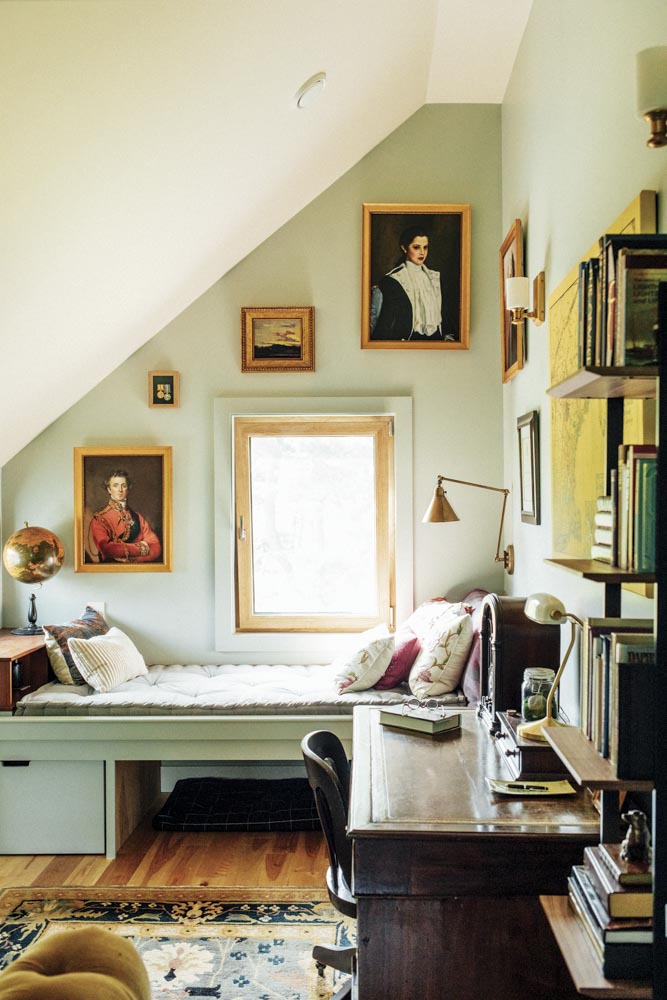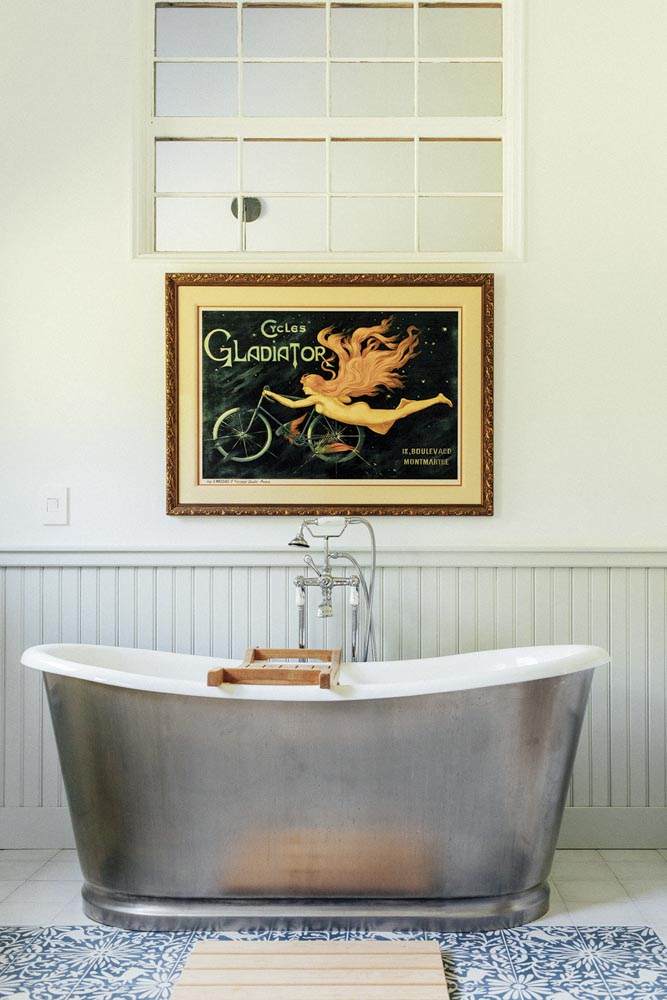By Sarah Stebbins
From the Fall 2023 issue of Maine Homes by Down East
On the coast and in the woods, in subdivisions and in former summer communities, Maine houses are becoming tighter, cleaner, and, in some cases, nearly or fully self-sustaining. Here, we introduce you to five sets of owners who took different routes to realizing a high-performing home without compromising on dream features, be it a “Harry Potter room” or a bath designed for luxuriating — and dog washing.
SUPER NATURAL

House Hunting
For more than a decade, a Portland couple and a Boston couple who are longtime friends (and asked that their names be withheld) dreamed of owning a place together in Phippsburg, where they’d spent many vacations. Then, on the same day in 2017, both camps emailed each other a listing for a three-acre ledgy parcel on Sebasco Harbor. After one visit, they made an offer. The existing cottage was rotted through, so the group set about designing a new, sustainable retreat with Portland architect Eric Sokol. Investing in efficient features, such as geothermal heat pumps that move heat from the ground into the home, triple-glazed windows, and 12-inch-thick walls filled with cellulose insulation, was a no-brainer, the Portland wife says. “Because we were sharing the cost, it was like everything was half off!”

Treading Lightly
“You can make the land conform to the house or the house can conform to the land,” says Sokol, who leaned hard in the latter direction, bending the building around the existing ledge to avoid blasting. A single story, save a projected loft that beams in southerly light, the home hunkers on its hilltop and ushers in water views with expansive glazing, including a 16-foot-wide slider in the dining space. Half-inch-thick cedar shingles (more durable than standard 5/16–inch-thick ones) will weather to the gray of the rocks and, soon, a planted roof will provide additional insulation while feathering the structure into the surrounding trees.
Team Effort
The Portland wife and Boston husband served as the point people on the project, working with Sokol and Phippsburg contractor R.W. Stevens to select materials, such as locally sourced pine paneling in a relatively knot-free premium grade for a modern look and recycled-paper countertops. If you’re going to build with friends (and stay on speaking terms), “you need to distill it down to one or two decision makers to remove as much complexity as you can,” the Boston husband says. Flexibility is also key. Case in point: The Boston couple was set on concrete flooring, while the Portlanders wanted wood. The Mainers capitulated, but the concrete got damaged during installation and they wound up putting reclaimed elm on top. “We ended up going with their plan, but they were willing to give in for us,” the Boston husband says. And they all remain great friends.

Architect: Winkelman Architecture
General Contractor: R.W. Stevens
Square Feet: 1,800
Bedrooms: 3
Baths: 1 1⁄2
Heat/Electricity: Geothermal heat pumps, HearthStone woodstove, backup propane generator, wired for future solar panels
Annual Cost for Heat/Electricity: $2,500
FARMHOUSE REBOOT

Cross-Country Collab
Four years ago, Kay and Alicia (who asked that their surnames be withheld) were pondering a return to Maine from San Diego, when Alicia saw a Maine Homes story about eco-friendly subdivisions. One, in Cumberland, developed by builder Patrice Cappelletti and architect Emily Mottram, would eventually comprise five net-zero or net-zero-ready houses that generate, or are capable of generating, more energy than they consume in a year. “I thought, isn’t it marvelous that it’s a woman architect and builder?” Alicia says. “And this seems like it should be the standard for the way things are built.” She emailed Cappelletti to applaud her work, and the two struck up a long-distance friendship. Then the last lot in the Cumberland development unexpectedly became available. Cappelletti offered it to Kay and Alicia, who bought it sight unseen. Over the next year, they worked over Zoom with Cappelletti and Mottram, who have since formed the Cumberland design-build firm The Nesting Ground, to conceive their home. “I’m a nurse and Kay’s a doctor,” Alicia says. “We like to know, down to the letter, what we’re doing. So this was a weird leap of faith.”


Photos by Dave Waddell
New Traditional
When Cappelletti and Mottram began collaborating, in 2015, “I felt like energy-efficient houses were getting a bad rap because they were all super-modern,” Mottram says. By contrast, Kay and Alicia’s place resembles a classic farmhouse with contemporary flair, expressed in the trimless, grilleless, triple-glazed windows and mix of vertical, thermally modified spruce siding, which resists rot and pests, horizontal hemlock clapboards (mounted rough side out for texture and better paint adhesion), and cedar shingles. Inside, Cappelletti used an antique hemlock beam and fireplace surround in the kitchen/living area, vintage interior windows, and beadboard and nickel-gap paneling atop 10 1⁄2-inch-thick, cellulose-filled walls to “build character.”
Marrying Styles
“I have a clean, Scandinavian aesthetic and Kay’s more British maximalist,” Alicia says. They compromised (sort of) by juxtaposing sleek furnishings and muted shades with a few of Kay’s choices, such as a delft-tile kitchen backsplash depicting woodland creatures and folk-art-inspired floor tile fronting a luxurious cast-iron soaking tub in the upstairs bath. One spot that’s all Kay’s: a little slanted study, dubbed “the Harry Potter room,” furnished with an antique mahogany sea-captain’s desk, reproduction portraits of 19th-century dukes and a young Vanderbilt, and a Victorian-era cast-iron fireplace surround. “Emily wouldn’t let us have a working fireplace because it would make too many holes in the house,” Kay says with a laugh.

Architect/General Contractor: The Nesting Ground
Square Feet: 2,562
Bedrooms: 4
Baths: 2 1⁄2
Heat/Electricity: Air-source heat pumps, Mørso woodstove, radiant bath flooring, 8.04kW solar array, backup solar batteries
Annual Cost for Heat/Electricity: $409
MOD COTTAGE

Community Spirit
In the early 20th century, day trippers and summer residents rode a trolley from Portland to Cumberland Foreside’s Wildwood Park neighborhood, composed of some 60 cottages, a restaurant/inn, and a sandy beach that winds along Broad Cove. Last spring, Joanne and Jim Berg drove their plug-in hybrid car from Arizona to their new place on one of those summerhouse plots. The move, their 12th in 44 years of marriage, brought them closer to their two adult children, both of whom have settled in Maine, and is meant to be their last. Their goal: “to live in a low-energy-use place, made of good, sturdy materials, with no drafts,” Joanne says. The fact that they also landed in what is now a close-knit, year-round community with a lively trick-or-treating scene “makes us feel incredibly lucky.”

Old Meets New
The Bergs’s place comprised a 1918 carriage house, used as living quarters, and a connected 2000 cottage with a cathedral ceiling of exposed timber framing they loved. Working with Portland architect Harry Hepburn and builder Dan Kolbert, they opted to preserve the cottage’s shell (and pine flooring to repurpose on screened-porch and portico ceilings) and continue its soaring living-room ceiling into the kitchen, housed in a new rear bump-out. Clad in pale cedar clapboards, the reimagined cottage provides a foil for a two-story addition of charcoal-stained cedar, erected where the unsalvageable carriage house had been. “They didn’t want it to feel like a big house, so this was a way to break down the scale and help it blend with the landscape,” Hepburn says of the yin-yang approach.
Weighing Options
From a cost perspective, reusing the existing structure versus building new “was probably a wash,” says Kolbert, whose crew had to reconstruct the original cottage’s floor framing and insulate the foundation. “But we saved a fair amount of concrete, which is often the highest single element in the ‘carbon budget.’” And the Bergs wound up with the tight, toasty house they sought, thanks to 11-inch-thick walls stuffed with cellulose insulation and triple-glazed windows, many of them trained on the cove and 23 acres of wooded conservation land. “My dream was to sit in our living room, look out the window at the snow, and be cozy,” Joanne says. A few months before moving here full-time, “I lived that dream on Christmas.”

Architect: Briburn
General Contractor: Kolbert Building
Square Feet: 1,904
Bedrooms: 3
Baths: 2
Heat/Electricity: Air-source heat pumps, Rais gas stove, wired for future solar panels
Annual Cost for Heat/ Electricity: Not available yet
SOLID PLAN

Semi-Custom Design
After purchasing their 20-acre wooded Kennebunkport lot, in 2019, Lisa Condit and Dan Macauley faced long lead times from architects versed in sustainable design. An efficient modular home would go up faster, but the large components couldn’t be trucked in on their narrow dirt road. Finally, they landed on a prefab plan they could customize and build on-site. Over six months, Jessica Benner, senior project coordinator at Portland’s BrightBuilt Home, worked with the couple to expand the company’s farmhouse-esque Cushing model, tweak the layout, and tack on a garage and lofty, ipe-clad, three-season porch. Going the semi-custom route, rather than starting from scratch, delivered the green features Condit and Macauley were after — 11-inch-thick walls packed with cellulose insulation, triple-glazed windows, net-zero capability — while saving tens of thousands of dollars in design fees.

Built to Last
“To us, sustainability also means not having to renovate in 10 years,” says Condit, who worked with Benner and Kennebunk high-performance builders Christi and Kurt Hissong to spec hyper-durable materials, such as aluminum roofing, cedar clapboards, concrete flooring, ipe decking, and German-made Bulthaup walnut and aluminum kitchen cabinetry. The gabled exterior harmonizes with the rural landscape, while the streamlined interior is timeless and adaptable — a second-floor hangout space, for example, could easily be walled off to become a bedroom — and light on fussy details. “We didn’t do a lot of built-ins because every time I watch a design show they are the first things people tear out,” Condit says.
Pet-Friendly Features
To facilitate life with furry friends, and minimize allergens and pollutants, Condit and Macauley stash their cats’ litter boxes in a nook beneath the stairs outfitted with a sliding door and a vent tied into their air-circulation system. The glassed-in wet room in their bath has an egg-shaped soaking tub for luxuriating in, and an attached wand for dog washing; additional wands beneath the room’s dual showerheads are used to spray fur off the walls and floor. Pups can also rinse off in the ipe-clad outdoor shower and dine at an ergonomic height, thanks to dishes installed on a raised bracket in the kitchen.

Architect: BrightBuilt Home
General Contractor: Proper Modern Home
Square Feet: 3,075
Bedrooms: 3
Baths: 2 1⁄2
Heat/Electricity: Ducted and air-source heat pumps, Hase woodstove, radiant bath flooring, backup propane generator, solar-panel installation in September
Annual Cost for Heat/Electricity: $4,359
FAB REHAB

Kitchen Goals
“We had great views, but we were looking at cabinets,” says Neil Gilbert, referring to the kitchen in the 1995 Colonial-style house on Scarborough’s Grondin Pond that he and his wife, Virginia, purchased in 2015. They enlisted residential designer Rachel Conly and contractor Heather Thompson, who have since formed Portland’s Juniper Design + Build with partner Mark Pollard, to reorient and modernize the space, outfitted with dark wood cabinetry and a single, small window. In the process, they decided to knock down walls and create an expansive kitchen/dining/living area with a 22-foot-long stretch of water-facing, triple-paned glass, housed in a little bump-out that opens onto a tiered cedar deck. Upstairs, they renovated a pair of bedrooms and baths and moved the primary suite to a room above the garage. “Once they were here, it made sense to do it all and make things more energy efficient,” Virginia says.

Thoughtful Approach
“There’s a new philosophy in renovating that it’s often better to electrify a house and do the best you can with air sealing than to do a gut renovation,” Thompson says. “There’s a carbon and financial cost in materials, so let’s focus on the areas where you can have the most impact and save money.” In addition to installing heat pumps, the Juniper team replaced much of the home’s siding with radiata pine clapboards mounted atop a weather-resistant air barrier and five-and-a-half inches of dense-pack cellulose insulation; swapped all the windows for triple-glazed versions; and added wall and ceiling air barriers between the garage and living spaces to prevent carbon monoxide from seeping into the house. “In the early days of green building, they called an attached garage the Kevorkian option,” Pollard says.

Clever Design
Conly set off the rear-kitchen and front-entry bump-outs with stained hemlock clapboards, giving them modern presence, designed a new stairwell to the primary suite with artful shafts of recessed LED strip lighting on the walls, and conceived a water-facing pickled-oak headboard for the couple with an integrated porcelain gas-fireplace surround and a walnut-topped storage bench on the opposing side. In winter, the Gilberts switch on that fireplace, or light the existing wood-burning one in the living room, for ambiance. Not because they’re actually chilly. “Our furnace used to stay on pretty much all the time,” Neil says. “Last winter, we barely turned on the heat.”

Architect/General Contractor: Juniper Design + Build
Square Feet: 4,605
Bedrooms: 4
Baths: 4 1⁄2 baths
Heat/Electricity: Air-source heat pumps, gas and wood-burning fireplaces, radiant bath flooring, supplemental electric baseboards and oil furnace
Annual Cost for Heat/Electricity: $7,800


